David Simon's Blog, page 11
February 14, 2018
The Jerusalem Lion’s Gate
The king made a great throne covered with ivory and overlaid with fine gold. The throne had six steps, and its back had a rounded top. On both sides of the seat were armrests, with a lion standing beside each of them. Twelve lions stood on the six steps, one at either end of each step. (1 Kings 10:18-20)
 Lions on the Stephen's GateSolomon’s throne was magnificent. The Bible says no other king had a throne so rich, elaborate or protecting. While history records the Babylonian and Egyptian kings had lions by their thrones (sometimes winged), King Solomon went further, employing twelve lions (one for each tribe) to stand before his elaborate throne. All who entered his palace were amazed by the beauty of the building and his wealth.
Lions on the Stephen's GateSolomon’s throne was magnificent. The Bible says no other king had a throne so rich, elaborate or protecting. While history records the Babylonian and Egyptian kings had lions by their thrones (sometimes winged), King Solomon went further, employing twelve lions (one for each tribe) to stand before his elaborate throne. All who entered his palace were amazed by the beauty of the building and his wealth.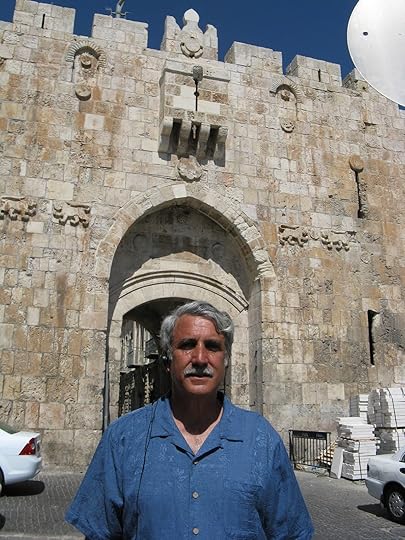 Stephen's Gate in JerusalemThe lion became a symbol of royalty from ancient times. Jacob predicted, “You are a lion’s cub, Judah; you return from the prey, my son. Like a lion he crouches and lies down, like a lioness—who dares to rouse him?” (Ge 49:9). Lions decorate the thrones of the King of England, China, Tibet, Burma and many other nations. Lions also decorate one of the gates into the city of Jerusalem, also known as the Stephen Gate.
Stephen's Gate in JerusalemThe lion became a symbol of royalty from ancient times. Jacob predicted, “You are a lion’s cub, Judah; you return from the prey, my son. Like a lion he crouches and lies down, like a lioness—who dares to rouse him?” (Ge 49:9). Lions decorate the thrones of the King of England, China, Tibet, Burma and many other nations. Lions also decorate one of the gates into the city of Jerusalem, also known as the Stephen Gate.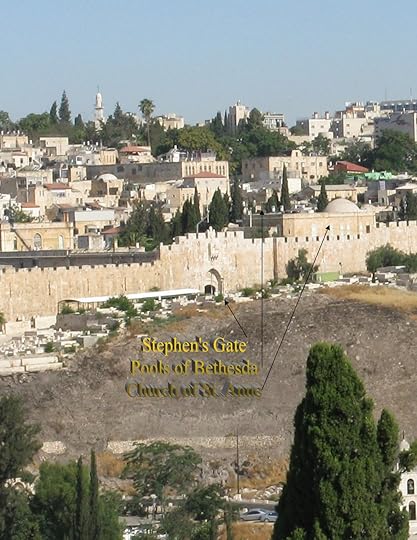 Lion's Gate in JerusalemThe lions on this gate, it is said, were placed on the facade because King Suleiman the Magnificent of the Ottoman Empire had a dream about 600 years ago in which he was attacked by four lions at the Jordan River. When he asked his wise men to discern the meaning of his vision, he was told it was to protect Jerusalem from his taxation (more can be found in my book Israel: Stories for Your Journey). The lions were emblazoned on an eastern gate which faces the Jordan River.
Lion's Gate in JerusalemThe lions on this gate, it is said, were placed on the facade because King Suleiman the Magnificent of the Ottoman Empire had a dream about 600 years ago in which he was attacked by four lions at the Jordan River. When he asked his wise men to discern the meaning of his vision, he was told it was to protect Jerusalem from his taxation (more can be found in my book Israel: Stories for Your Journey). The lions were emblazoned on an eastern gate which faces the Jordan River. Stories Your Guide won't Tell YThis gate is the entry point for pilgrims today who journey down the Mount of Olives to traverse the Via Dolorosa in Jerusalem. It is believed by some that the King of Kings, the Lion of the Tribe of Judah entered this gate, and he probably did, at some point, but not on Palm Sunday. The lions are still appropriate and the gate is a great entryway into Jerusalem for pilgrims who come to visit the holy sites such as Saint Anne’s Chapel, the pool of Bethesda, or the The Ecce Homo church.
Stories Your Guide won't Tell YThis gate is the entry point for pilgrims today who journey down the Mount of Olives to traverse the Via Dolorosa in Jerusalem. It is believed by some that the King of Kings, the Lion of the Tribe of Judah entered this gate, and he probably did, at some point, but not on Palm Sunday. The lions are still appropriate and the gate is a great entryway into Jerusalem for pilgrims who come to visit the holy sites such as Saint Anne’s Chapel, the pool of Bethesda, or the The Ecce Homo church.
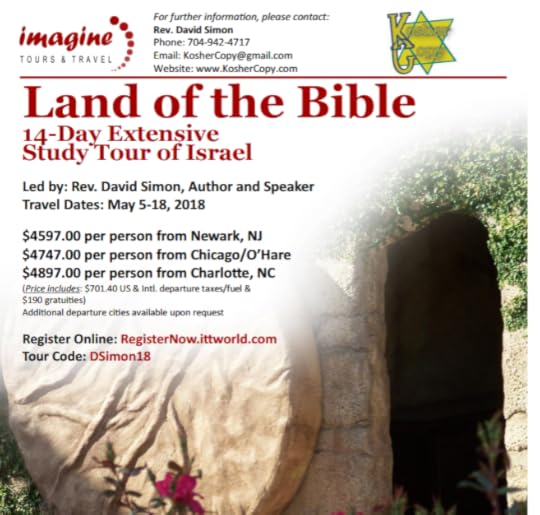 Details of our trip to Israel. Sign up Today!Jerusalem with its gates and holy sites is worth a visit. Please join me on my next trip May 5-18, 2018 (click this link for more details). If you can not go, please order my $2 book, Israel: Stories for Your Journey.
Details of our trip to Israel. Sign up Today!Jerusalem with its gates and holy sites is worth a visit. Please join me on my next trip May 5-18, 2018 (click this link for more details). If you can not go, please order my $2 book, Israel: Stories for Your Journey.
 Lions on the Stephen's GateSolomon’s throne was magnificent. The Bible says no other king had a throne so rich, elaborate or protecting. While history records the Babylonian and Egyptian kings had lions by their thrones (sometimes winged), King Solomon went further, employing twelve lions (one for each tribe) to stand before his elaborate throne. All who entered his palace were amazed by the beauty of the building and his wealth.
Lions on the Stephen's GateSolomon’s throne was magnificent. The Bible says no other king had a throne so rich, elaborate or protecting. While history records the Babylonian and Egyptian kings had lions by their thrones (sometimes winged), King Solomon went further, employing twelve lions (one for each tribe) to stand before his elaborate throne. All who entered his palace were amazed by the beauty of the building and his wealth. Stephen's Gate in JerusalemThe lion became a symbol of royalty from ancient times. Jacob predicted, “You are a lion’s cub, Judah; you return from the prey, my son. Like a lion he crouches and lies down, like a lioness—who dares to rouse him?” (Ge 49:9). Lions decorate the thrones of the King of England, China, Tibet, Burma and many other nations. Lions also decorate one of the gates into the city of Jerusalem, also known as the Stephen Gate.
Stephen's Gate in JerusalemThe lion became a symbol of royalty from ancient times. Jacob predicted, “You are a lion’s cub, Judah; you return from the prey, my son. Like a lion he crouches and lies down, like a lioness—who dares to rouse him?” (Ge 49:9). Lions decorate the thrones of the King of England, China, Tibet, Burma and many other nations. Lions also decorate one of the gates into the city of Jerusalem, also known as the Stephen Gate. Lion's Gate in JerusalemThe lions on this gate, it is said, were placed on the facade because King Suleiman the Magnificent of the Ottoman Empire had a dream about 600 years ago in which he was attacked by four lions at the Jordan River. When he asked his wise men to discern the meaning of his vision, he was told it was to protect Jerusalem from his taxation (more can be found in my book Israel: Stories for Your Journey). The lions were emblazoned on an eastern gate which faces the Jordan River.
Lion's Gate in JerusalemThe lions on this gate, it is said, were placed on the facade because King Suleiman the Magnificent of the Ottoman Empire had a dream about 600 years ago in which he was attacked by four lions at the Jordan River. When he asked his wise men to discern the meaning of his vision, he was told it was to protect Jerusalem from his taxation (more can be found in my book Israel: Stories for Your Journey). The lions were emblazoned on an eastern gate which faces the Jordan River. Stories Your Guide won't Tell YThis gate is the entry point for pilgrims today who journey down the Mount of Olives to traverse the Via Dolorosa in Jerusalem. It is believed by some that the King of Kings, the Lion of the Tribe of Judah entered this gate, and he probably did, at some point, but not on Palm Sunday. The lions are still appropriate and the gate is a great entryway into Jerusalem for pilgrims who come to visit the holy sites such as Saint Anne’s Chapel, the pool of Bethesda, or the The Ecce Homo church.
Stories Your Guide won't Tell YThis gate is the entry point for pilgrims today who journey down the Mount of Olives to traverse the Via Dolorosa in Jerusalem. It is believed by some that the King of Kings, the Lion of the Tribe of Judah entered this gate, and he probably did, at some point, but not on Palm Sunday. The lions are still appropriate and the gate is a great entryway into Jerusalem for pilgrims who come to visit the holy sites such as Saint Anne’s Chapel, the pool of Bethesda, or the The Ecce Homo church.
 Details of our trip to Israel. Sign up Today!Jerusalem with its gates and holy sites is worth a visit. Please join me on my next trip May 5-18, 2018 (click this link for more details). If you can not go, please order my $2 book, Israel: Stories for Your Journey.
Details of our trip to Israel. Sign up Today!Jerusalem with its gates and holy sites is worth a visit. Please join me on my next trip May 5-18, 2018 (click this link for more details). If you can not go, please order my $2 book, Israel: Stories for Your Journey.
Published on February 14, 2018 03:00
February 12, 2018
Abraham Lincoln's Birthday
Over the past several years I have become more and more aware of people’s lack of knowledge, understanding or desire for a sense of history. In the past couple days as I shared with people my recent trip to the wreath laying at William Henry Harrison’s tomb, they wondered, “Who was he?” and “He was only in office one month!” So I shared the story of how William Henry Harrison’s lifetime of work caused people to make him run for the office of President. This man did many great things for our country.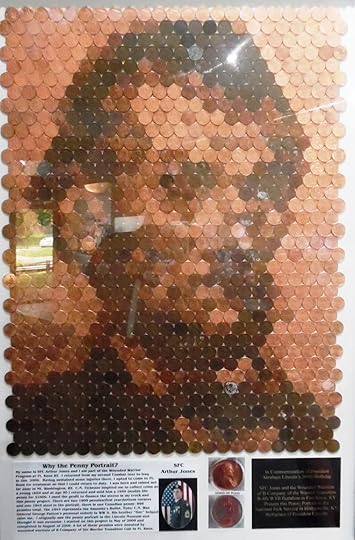 Lincoln's Portrait in PenniesToday we celebrate the birthday of another great president, Abraham Lincoln. This president has name recognition and many would call him their favorite of all presidents.
Lincoln's Portrait in PenniesToday we celebrate the birthday of another great president, Abraham Lincoln. This president has name recognition and many would call him their favorite of all presidents.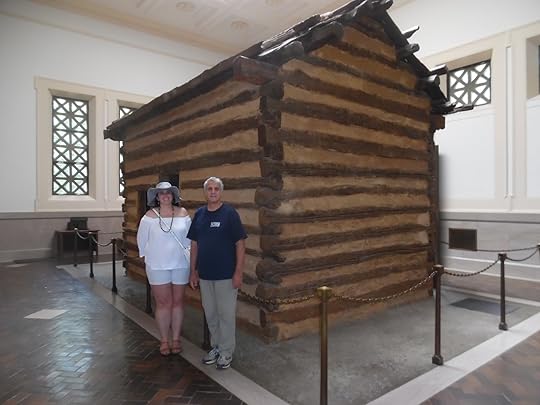 The supposed cabin where Lincoln was bornAbraham Lincoln was born 209 years ago on February 12, 1809, at Sinking Spring farm, south of Hodgenville in a small log cabin. Last year I visited the historic site and learned that a log cabin called “Lincoln’s Birthplace” became a tourist attraction in the 1890’s. It was displayed at the Tennessee Centennial Exposition in 1897, and then toured the country, with another log cabin, that of Jefferson Davis. Along the way the logs got mixed up, and the cabin of today contains logs from both cabins.
The supposed cabin where Lincoln was bornAbraham Lincoln was born 209 years ago on February 12, 1809, at Sinking Spring farm, south of Hodgenville in a small log cabin. Last year I visited the historic site and learned that a log cabin called “Lincoln’s Birthplace” became a tourist attraction in the 1890’s. It was displayed at the Tennessee Centennial Exposition in 1897, and then toured the country, with another log cabin, that of Jefferson Davis. Along the way the logs got mixed up, and the cabin of today contains logs from both cabins.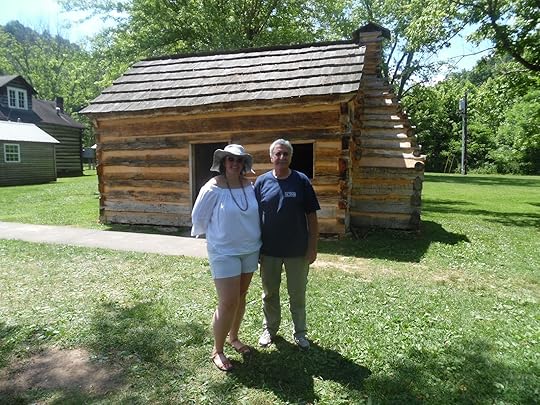 Lincoln's Boyhood home at Knob CreekThe earliest home Lincoln remembers was where his parents moved in 1811, a few miles north of Hodgenville along Knob Creek.
Lincoln's Boyhood home at Knob CreekThe earliest home Lincoln remembers was where his parents moved in 1811, a few miles north of Hodgenville along Knob Creek.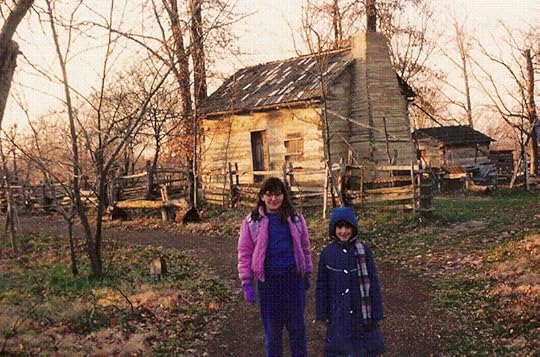 Lincoln's childhood home in Spencer County, IndianaAt the age of 7 Lincoln’s family moved to Buffaloville, Indiana (near Santa Claus). The future president lived at this location until he was 17, and left home to work on a Mississippi flatboat. Buffaloville is the place where we hear stories of Abraham Lincoln teaching himself to read by the fireplace in the evening. This is also the place the future president gained his strength by farming and splitting rails.
Lincoln's childhood home in Spencer County, IndianaAt the age of 7 Lincoln’s family moved to Buffaloville, Indiana (near Santa Claus). The future president lived at this location until he was 17, and left home to work on a Mississippi flatboat. Buffaloville is the place where we hear stories of Abraham Lincoln teaching himself to read by the fireplace in the evening. This is also the place the future president gained his strength by farming and splitting rails.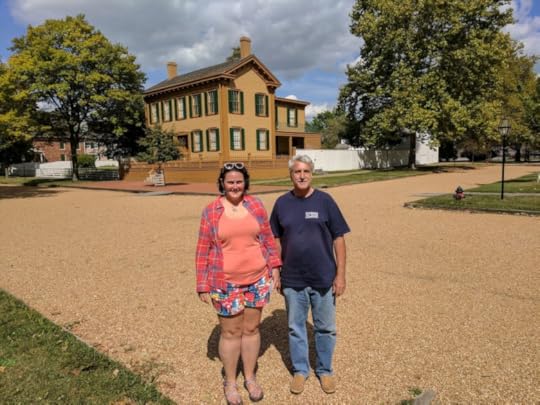 Lincoln''s home in Springfield, IllinoisBy the age of 23, Lincoln and his father had moved to Illinois, and the young man became interested in politics, law and Indian fighting. He supported William Henry Harrison in the 1840 Presidential election. He served as a state legislator from 1834-1842, and in the United States House of Representatives, 1847–49. He moved to Springfield, IL in 1836, and built a small home in the city after his marriage to Mary Todd in 1842.
Lincoln''s home in Springfield, IllinoisBy the age of 23, Lincoln and his father had moved to Illinois, and the young man became interested in politics, law and Indian fighting. He supported William Henry Harrison in the 1840 Presidential election. He served as a state legislator from 1834-1842, and in the United States House of Representatives, 1847–49. He moved to Springfield, IL in 1836, and built a small home in the city after his marriage to Mary Todd in 1842.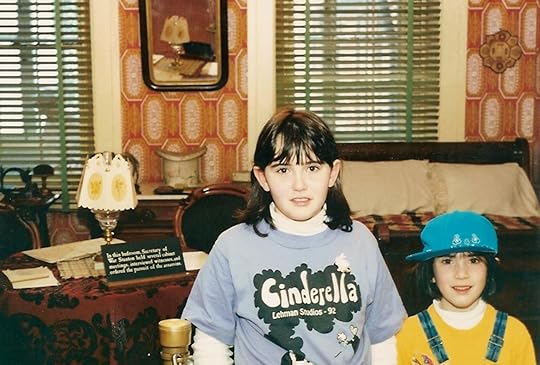 The house where Lincoln died
The house where Lincoln died
Teaching our children about our nation’s history is of great importance, for as children learn the lessons of history they learn to avoid the mistakes of the past. They also hear about men and women they can emulate in order to become great leaders of the future. I have always felt it is good to take my children to places where historic events took place, because young children more easily absorb lessons from their environment than lessons which are conveyed through the spoken voice.
 Lincoln's Portrait in PenniesToday we celebrate the birthday of another great president, Abraham Lincoln. This president has name recognition and many would call him their favorite of all presidents.
Lincoln's Portrait in PenniesToday we celebrate the birthday of another great president, Abraham Lincoln. This president has name recognition and many would call him their favorite of all presidents. The supposed cabin where Lincoln was bornAbraham Lincoln was born 209 years ago on February 12, 1809, at Sinking Spring farm, south of Hodgenville in a small log cabin. Last year I visited the historic site and learned that a log cabin called “Lincoln’s Birthplace” became a tourist attraction in the 1890’s. It was displayed at the Tennessee Centennial Exposition in 1897, and then toured the country, with another log cabin, that of Jefferson Davis. Along the way the logs got mixed up, and the cabin of today contains logs from both cabins.
The supposed cabin where Lincoln was bornAbraham Lincoln was born 209 years ago on February 12, 1809, at Sinking Spring farm, south of Hodgenville in a small log cabin. Last year I visited the historic site and learned that a log cabin called “Lincoln’s Birthplace” became a tourist attraction in the 1890’s. It was displayed at the Tennessee Centennial Exposition in 1897, and then toured the country, with another log cabin, that of Jefferson Davis. Along the way the logs got mixed up, and the cabin of today contains logs from both cabins. Lincoln's Boyhood home at Knob CreekThe earliest home Lincoln remembers was where his parents moved in 1811, a few miles north of Hodgenville along Knob Creek.
Lincoln's Boyhood home at Knob CreekThe earliest home Lincoln remembers was where his parents moved in 1811, a few miles north of Hodgenville along Knob Creek. Lincoln's childhood home in Spencer County, IndianaAt the age of 7 Lincoln’s family moved to Buffaloville, Indiana (near Santa Claus). The future president lived at this location until he was 17, and left home to work on a Mississippi flatboat. Buffaloville is the place where we hear stories of Abraham Lincoln teaching himself to read by the fireplace in the evening. This is also the place the future president gained his strength by farming and splitting rails.
Lincoln's childhood home in Spencer County, IndianaAt the age of 7 Lincoln’s family moved to Buffaloville, Indiana (near Santa Claus). The future president lived at this location until he was 17, and left home to work on a Mississippi flatboat. Buffaloville is the place where we hear stories of Abraham Lincoln teaching himself to read by the fireplace in the evening. This is also the place the future president gained his strength by farming and splitting rails. Lincoln''s home in Springfield, IllinoisBy the age of 23, Lincoln and his father had moved to Illinois, and the young man became interested in politics, law and Indian fighting. He supported William Henry Harrison in the 1840 Presidential election. He served as a state legislator from 1834-1842, and in the United States House of Representatives, 1847–49. He moved to Springfield, IL in 1836, and built a small home in the city after his marriage to Mary Todd in 1842.
Lincoln''s home in Springfield, IllinoisBy the age of 23, Lincoln and his father had moved to Illinois, and the young man became interested in politics, law and Indian fighting. He supported William Henry Harrison in the 1840 Presidential election. He served as a state legislator from 1834-1842, and in the United States House of Representatives, 1847–49. He moved to Springfield, IL in 1836, and built a small home in the city after his marriage to Mary Todd in 1842. The house where Lincoln died
The house where Lincoln diedTeaching our children about our nation’s history is of great importance, for as children learn the lessons of history they learn to avoid the mistakes of the past. They also hear about men and women they can emulate in order to become great leaders of the future. I have always felt it is good to take my children to places where historic events took place, because young children more easily absorb lessons from their environment than lessons which are conveyed through the spoken voice.
Published on February 12, 2018 11:49
February 10, 2018
Yesterday my family and I attended a wreath laying ceremo...
Yesterday my family and I attended a wreath laying ceremony at the grave of William Henry Harrison, the ninth President of the United States. I tell about how we came to participate at this event in my last two blogs. I did not know until this event that wreaths are set at the grave of each president annually on (or near) his birthday. I thought this ceremony would be small, but I was wrong. These wreath settings are well planned, well attended because they are quite elaborate. A video can be seen at this link.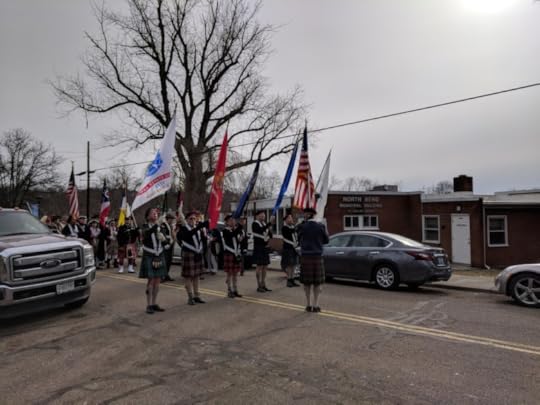 A color guard led the procession from North Bend Town Hall to the grave site of President William Henry HarrisonThe ceremony for William Henry Harrison began at North Bend City Hall.
A color guard led the procession from North Bend Town Hall to the grave site of President William Henry HarrisonThe ceremony for William Henry Harrison began at North Bend City Hall.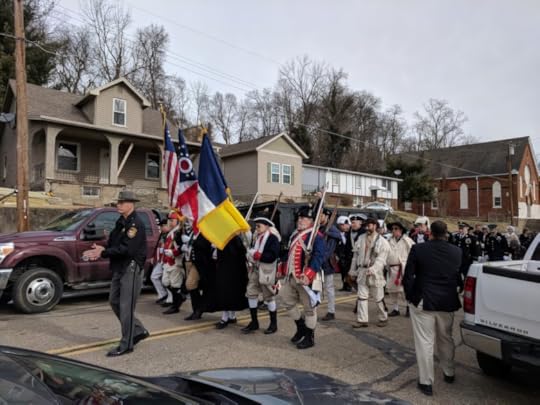 Sons and Daughters of the Revolution joined the procession behind the flags.There were costumed participants from Sons and Daughters of the Revolution. William Henry Harrison was the last President born the colonial period of our country. He was also the last president to personally know every man who served as President before him.
Sons and Daughters of the Revolution joined the procession behind the flags.There were costumed participants from Sons and Daughters of the Revolution. William Henry Harrison was the last President born the colonial period of our country. He was also the last president to personally know every man who served as President before him.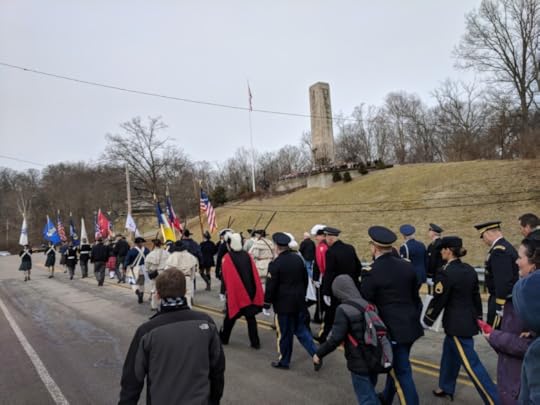 The procession as it reaches the hill where our former president was buried.We walked three blocks to the grave site. A color guard led the parade, followed by costumed personnel, military commanders, guests and then the High School band.
The procession as it reaches the hill where our former president was buried.We walked three blocks to the grave site. A color guard led the parade, followed by costumed personnel, military commanders, guests and then the High School band.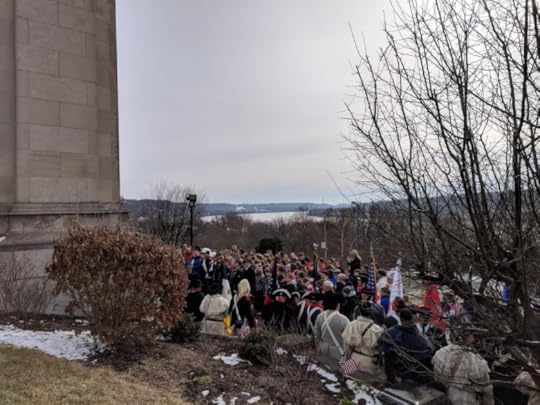 A view looking east from the grave siteWe gathered at the beautiful spot above the Ohio River.
A view looking east from the grave siteWe gathered at the beautiful spot above the Ohio River.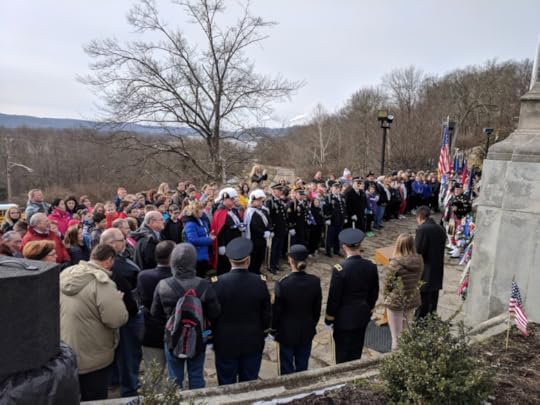 A view looking west from the grave site. The North Bend Mayor is speakingThe mayor of North Bend spoke first and MC’d the program.
A view looking west from the grave site. The North Bend Mayor is speakingThe mayor of North Bend spoke first and MC’d the program.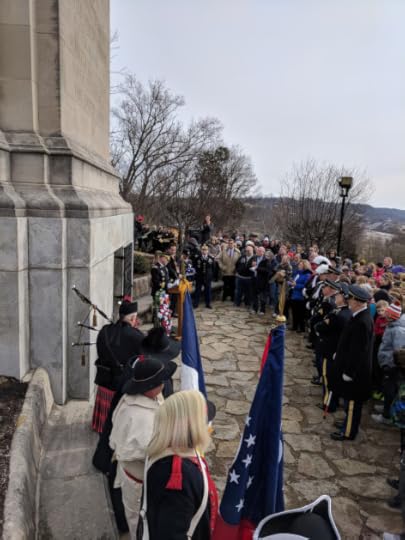 An Army General brought the wreath and spoke about President Harrison's accomplishments
An Army General brought the wreath and spoke about President Harrison's accomplishments
President Trump sent a representative, a general in the army, to lay the wreath.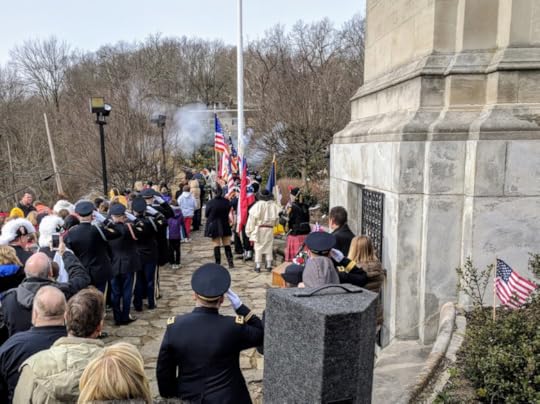 The twenty-one musket saluteThere were flag ceremonies and presentations, other wreaths set in place, and a 21 gun salute.
The twenty-one musket saluteThere were flag ceremonies and presentations, other wreaths set in place, and a 21 gun salute.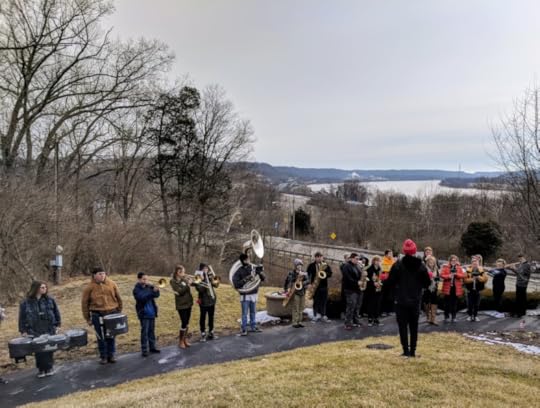 The High School BandThe local high school band played for the event.
The High School BandThe local high school band played for the event.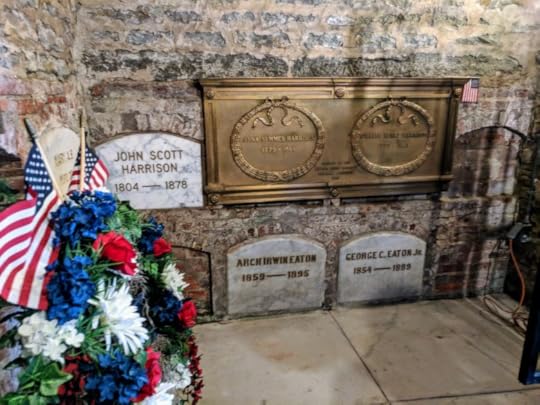 Inside President Harrison's tomb
Inside President Harrison's tomb
The entire event was very impressive. This is my first time attending such an event. I will probably look up some other events and celebrate our nation’s great history.
 A color guard led the procession from North Bend Town Hall to the grave site of President William Henry HarrisonThe ceremony for William Henry Harrison began at North Bend City Hall.
A color guard led the procession from North Bend Town Hall to the grave site of President William Henry HarrisonThe ceremony for William Henry Harrison began at North Bend City Hall. Sons and Daughters of the Revolution joined the procession behind the flags.There were costumed participants from Sons and Daughters of the Revolution. William Henry Harrison was the last President born the colonial period of our country. He was also the last president to personally know every man who served as President before him.
Sons and Daughters of the Revolution joined the procession behind the flags.There were costumed participants from Sons and Daughters of the Revolution. William Henry Harrison was the last President born the colonial period of our country. He was also the last president to personally know every man who served as President before him. The procession as it reaches the hill where our former president was buried.We walked three blocks to the grave site. A color guard led the parade, followed by costumed personnel, military commanders, guests and then the High School band.
The procession as it reaches the hill where our former president was buried.We walked three blocks to the grave site. A color guard led the parade, followed by costumed personnel, military commanders, guests and then the High School band. A view looking east from the grave siteWe gathered at the beautiful spot above the Ohio River.
A view looking east from the grave siteWe gathered at the beautiful spot above the Ohio River. A view looking west from the grave site. The North Bend Mayor is speakingThe mayor of North Bend spoke first and MC’d the program.
A view looking west from the grave site. The North Bend Mayor is speakingThe mayor of North Bend spoke first and MC’d the program. An Army General brought the wreath and spoke about President Harrison's accomplishments
An Army General brought the wreath and spoke about President Harrison's accomplishmentsPresident Trump sent a representative, a general in the army, to lay the wreath.
 The twenty-one musket saluteThere were flag ceremonies and presentations, other wreaths set in place, and a 21 gun salute.
The twenty-one musket saluteThere were flag ceremonies and presentations, other wreaths set in place, and a 21 gun salute. The High School BandThe local high school band played for the event.
The High School BandThe local high school band played for the event. Inside President Harrison's tomb
Inside President Harrison's tombThe entire event was very impressive. This is my first time attending such an event. I will probably look up some other events and celebrate our nation’s great history.
Published on February 10, 2018 19:00
February 9, 2018
The President's One Big Mistake
In the past year I have learned a lot about William Henry Harrison. For years I told people he was our most perfect president, “he only made one mistake while in office, he went to his own inauguration.” The fact is that Thursday, March 4, 1841 was a very cold day. Sixty-eight year old “Tippecanoe” did not wear a hat, overcoat, or gloves, and stood outside to deliver the longest inauguration speech on record. As a result he caught pneumonia and died thirty-one days into his term of office.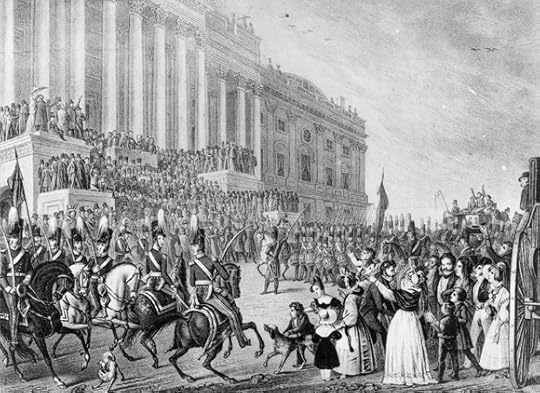 William Henry Harrison Inauguration Quite by accident this year, my family has traveled in the areas where William Henry Harrison lived. He was born at Berkeley Plantation between Williamsburg and Richmond, Virginia in 1773. He was the son of Benjamin Harrison V, a Burgess who signed the Declaration of Independence and participated in the ratification of the Constitution. The Harrison family was well acquainted with national leaders of his day, and William Henry Harrison personally knew every man who served as President of the United States before him. He was the ninth President of the United States.
William Henry Harrison Inauguration Quite by accident this year, my family has traveled in the areas where William Henry Harrison lived. He was born at Berkeley Plantation between Williamsburg and Richmond, Virginia in 1773. He was the son of Benjamin Harrison V, a Burgess who signed the Declaration of Independence and participated in the ratification of the Constitution. The Harrison family was well acquainted with national leaders of his day, and William Henry Harrison personally knew every man who served as President of the United States before him. He was the ninth President of the United States.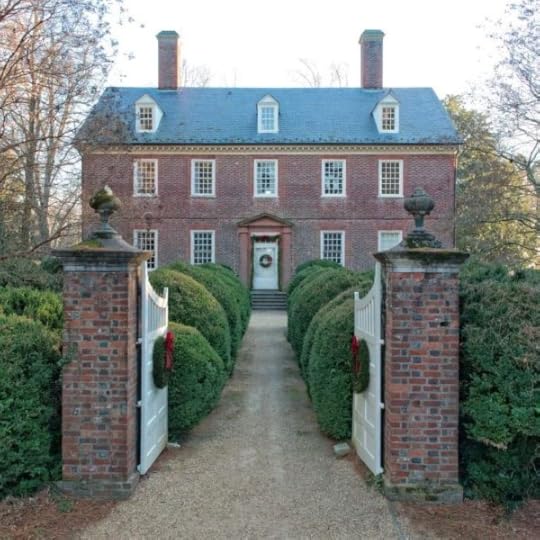 Berkeley Plantation in VirginiaWilliam Henry Harrison served a distinguished career in the military, served as the first governor of Indiana Territory, defeated Tecumseh at the battle of Tippecanoe, served in the United States House of Representatives. the United States Senate and as foreign minister to Columbia where he worked to point president Simón Bolívar, toward formation of a democracy. We visited Grouseland, Harrison’s home in Vincennes, Indiana this year in our travels, which holds many mementos of this remarkable man.
Berkeley Plantation in VirginiaWilliam Henry Harrison served a distinguished career in the military, served as the first governor of Indiana Territory, defeated Tecumseh at the battle of Tippecanoe, served in the United States House of Representatives. the United States Senate and as foreign minister to Columbia where he worked to point president Simón Bolívar, toward formation of a democracy. We visited Grouseland, Harrison’s home in Vincennes, Indiana this year in our travels, which holds many mementos of this remarkable man.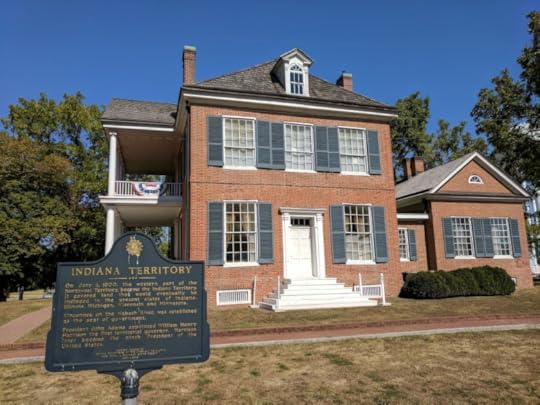 Grouceland Plantation in IndianaToday is William Henry Harrison’s Birthday. If he were alive it would be number 245. I will be attending a wreath hanging ceremony in North Bend, Ohio. Tomorrow I hope to post some pictures from the event.
Grouceland Plantation in IndianaToday is William Henry Harrison’s Birthday. If he were alive it would be number 245. I will be attending a wreath hanging ceremony in North Bend, Ohio. Tomorrow I hope to post some pictures from the event.
 William Henry Harrison Inauguration Quite by accident this year, my family has traveled in the areas where William Henry Harrison lived. He was born at Berkeley Plantation between Williamsburg and Richmond, Virginia in 1773. He was the son of Benjamin Harrison V, a Burgess who signed the Declaration of Independence and participated in the ratification of the Constitution. The Harrison family was well acquainted with national leaders of his day, and William Henry Harrison personally knew every man who served as President of the United States before him. He was the ninth President of the United States.
William Henry Harrison Inauguration Quite by accident this year, my family has traveled in the areas where William Henry Harrison lived. He was born at Berkeley Plantation between Williamsburg and Richmond, Virginia in 1773. He was the son of Benjamin Harrison V, a Burgess who signed the Declaration of Independence and participated in the ratification of the Constitution. The Harrison family was well acquainted with national leaders of his day, and William Henry Harrison personally knew every man who served as President of the United States before him. He was the ninth President of the United States. Berkeley Plantation in VirginiaWilliam Henry Harrison served a distinguished career in the military, served as the first governor of Indiana Territory, defeated Tecumseh at the battle of Tippecanoe, served in the United States House of Representatives. the United States Senate and as foreign minister to Columbia where he worked to point president Simón Bolívar, toward formation of a democracy. We visited Grouseland, Harrison’s home in Vincennes, Indiana this year in our travels, which holds many mementos of this remarkable man.
Berkeley Plantation in VirginiaWilliam Henry Harrison served a distinguished career in the military, served as the first governor of Indiana Territory, defeated Tecumseh at the battle of Tippecanoe, served in the United States House of Representatives. the United States Senate and as foreign minister to Columbia where he worked to point president Simón Bolívar, toward formation of a democracy. We visited Grouseland, Harrison’s home in Vincennes, Indiana this year in our travels, which holds many mementos of this remarkable man. Grouceland Plantation in IndianaToday is William Henry Harrison’s Birthday. If he were alive it would be number 245. I will be attending a wreath hanging ceremony in North Bend, Ohio. Tomorrow I hope to post some pictures from the event.
Grouceland Plantation in IndianaToday is William Henry Harrison’s Birthday. If he were alive it would be number 245. I will be attending a wreath hanging ceremony in North Bend, Ohio. Tomorrow I hope to post some pictures from the event.
Published on February 09, 2018 03:30
February 8, 2018
Our Most Perfect President
For years I have told people our most perfect president was William Henry Harrison. Teasingly I tell them that he only made one mistake during his term in the White House .... he did not wear a hat to his inauguration. It was cold and he caught pneumonia and died about a month after taking office. This man, known as Tippecanoe, spoke for an hour and forty five minutes on the cold day, the longest inauguration speech on record, He was also the oldest president until Ronald Reagan and Donald Trump.
 William Henry Harrison built a home near North Bend, OhioAfter years of talking about the man, I decided to learn something about him. William Henry Harrison is buried in the county where my oldest daughter goes to school, Hamilton County, Ohio. Four of our presidents have ties to this area: William Howard Taft was born in Cincinnati; Ulysses S. Grant was born one county east; William Henry Harrison is buried in North Bend; and his grandson, Benjamin Harrison, was born in Hamilton, County. Because I am interested in history, I have visited sites related to these men when I visit my daughter.
William Henry Harrison built a home near North Bend, OhioAfter years of talking about the man, I decided to learn something about him. William Henry Harrison is buried in the county where my oldest daughter goes to school, Hamilton County, Ohio. Four of our presidents have ties to this area: William Howard Taft was born in Cincinnati; Ulysses S. Grant was born one county east; William Henry Harrison is buried in North Bend; and his grandson, Benjamin Harrison, was born in Hamilton, County. Because I am interested in history, I have visited sites related to these men when I visit my daughter.
 William Howard Taft was born in CincinnatiMy visit to the gravesite of William Henry Harrison occurred on a cold day in March of last year. We attempted to visit a museum near his home first, but the facility was closed. It seems the curator was on vacation in Europe (I know because I wrote to ask why the museum was closed during opened hours). We went on to the grave, which is close to where he built his home. It was an enjoyable day seeing the countryside and learning a bit about the man who served as our president for thirty-one days.
William Howard Taft was born in CincinnatiMy visit to the gravesite of William Henry Harrison occurred on a cold day in March of last year. We attempted to visit a museum near his home first, but the facility was closed. It seems the curator was on vacation in Europe (I know because I wrote to ask why the museum was closed during opened hours). We went on to the grave, which is close to where he built his home. It was an enjoyable day seeing the countryside and learning a bit about the man who served as our president for thirty-one days.
 Tippecanoe built a home with a view!!
Tippecanoe built a home with a view!!
When I inquired about why the museum was closed, the people I talked to told me about a wreath hanging program instituted by Gerald Ford when he was president. Every year a president’s birthday, a representative of the current president hangs a wreath at the grave site. I decided to visit the tomb of Tippecanoe once again this year to participate in the ceremony. The event happens on February 9.
 William Henry Harrison built a home near North Bend, OhioAfter years of talking about the man, I decided to learn something about him. William Henry Harrison is buried in the county where my oldest daughter goes to school, Hamilton County, Ohio. Four of our presidents have ties to this area: William Howard Taft was born in Cincinnati; Ulysses S. Grant was born one county east; William Henry Harrison is buried in North Bend; and his grandson, Benjamin Harrison, was born in Hamilton, County. Because I am interested in history, I have visited sites related to these men when I visit my daughter.
William Henry Harrison built a home near North Bend, OhioAfter years of talking about the man, I decided to learn something about him. William Henry Harrison is buried in the county where my oldest daughter goes to school, Hamilton County, Ohio. Four of our presidents have ties to this area: William Howard Taft was born in Cincinnati; Ulysses S. Grant was born one county east; William Henry Harrison is buried in North Bend; and his grandson, Benjamin Harrison, was born in Hamilton, County. Because I am interested in history, I have visited sites related to these men when I visit my daughter. William Howard Taft was born in CincinnatiMy visit to the gravesite of William Henry Harrison occurred on a cold day in March of last year. We attempted to visit a museum near his home first, but the facility was closed. It seems the curator was on vacation in Europe (I know because I wrote to ask why the museum was closed during opened hours). We went on to the grave, which is close to where he built his home. It was an enjoyable day seeing the countryside and learning a bit about the man who served as our president for thirty-one days.
William Howard Taft was born in CincinnatiMy visit to the gravesite of William Henry Harrison occurred on a cold day in March of last year. We attempted to visit a museum near his home first, but the facility was closed. It seems the curator was on vacation in Europe (I know because I wrote to ask why the museum was closed during opened hours). We went on to the grave, which is close to where he built his home. It was an enjoyable day seeing the countryside and learning a bit about the man who served as our president for thirty-one days. Tippecanoe built a home with a view!!
Tippecanoe built a home with a view!!When I inquired about why the museum was closed, the people I talked to told me about a wreath hanging program instituted by Gerald Ford when he was president. Every year a president’s birthday, a representative of the current president hangs a wreath at the grave site. I decided to visit the tomb of Tippecanoe once again this year to participate in the ceremony. The event happens on February 9.
Published on February 08, 2018 04:55
February 7, 2018
Joppa Gate
Pass through, pass through the gates! Prepare the way for the people. Build up, build up the highway! Remove the stones. Raise a banner for the nations. (Isaiah 62:10) Jaffa Gate from inside the walls of JerusalemThe Jaffa Gate is, in a way, the international gate of Jerusalem. The name shared most often today motions away from the city to the port city of Jaffa (and beyond that to Caesarea), from which travelers arrive into Eretz Yisrael from all over the world. From the days of King David, when King Hiram of Phoenicia passed by this gate, even until today travelers and others have written about the beautiful Jaffa Gate.
Jaffa Gate from inside the walls of JerusalemThe Jaffa Gate is, in a way, the international gate of Jerusalem. The name shared most often today motions away from the city to the port city of Jaffa (and beyond that to Caesarea), from which travelers arrive into Eretz Yisrael from all over the world. From the days of King David, when King Hiram of Phoenicia passed by this gate, even until today travelers and others have written about the beautiful Jaffa Gate.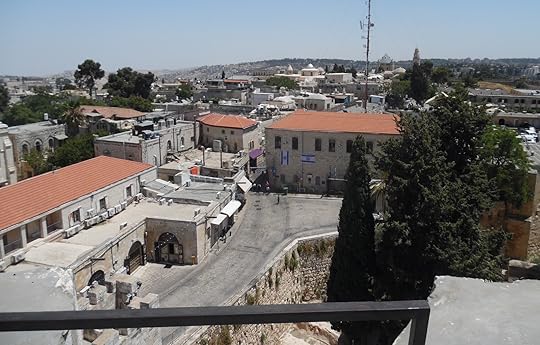 Looking down from the top of the Rampart WallsAt one time the gate was heavily guarded, with a double entry and heavy wooden doors which sat upon bronze hinges. Towers guarded this entrance, portions of which still stand today. King Herod named these towers Phasael (145’ high), Hippicus (132’) and Mariamne (74’) after his brother, a friend, and his favorite wife. Of these, only a portion of the Phasael tower stands today, and the gates were removed to allow Kaiser Wilhelm II easier access to the city in 1898. (More in my book, Israel: Stories for Your Journey)
Looking down from the top of the Rampart WallsAt one time the gate was heavily guarded, with a double entry and heavy wooden doors which sat upon bronze hinges. Towers guarded this entrance, portions of which still stand today. King Herod named these towers Phasael (145’ high), Hippicus (132’) and Mariamne (74’) after his brother, a friend, and his favorite wife. Of these, only a portion of the Phasael tower stands today, and the gates were removed to allow Kaiser Wilhelm II easier access to the city in 1898. (More in my book, Israel: Stories for Your Journey) A must for tourists to IsraelMost of the walls and gates of Jerusalem, which we see today, were ordered to be constructed by Sultan Suleiman the Magnificent who ruled the Ottoman Empire in the sixteenth century. A story is told of how he found the walls of Jerusalem in ruins after being visited by four lions in a dream. He sent two architects to build a wall following the original course of the city’s protective enclosure. When completed the Sultan visited the city, and when inspecting the work found it satisfactory with one exception. The Tomb of King David was left outside the walls. The two architects were hanged and put to rest in graves outside the Jaffa Gate.
A must for tourists to IsraelMost of the walls and gates of Jerusalem, which we see today, were ordered to be constructed by Sultan Suleiman the Magnificent who ruled the Ottoman Empire in the sixteenth century. A story is told of how he found the walls of Jerusalem in ruins after being visited by four lions in a dream. He sent two architects to build a wall following the original course of the city’s protective enclosure. When completed the Sultan visited the city, and when inspecting the work found it satisfactory with one exception. The Tomb of King David was left outside the walls. The two architects were hanged and put to rest in graves outside the Jaffa Gate.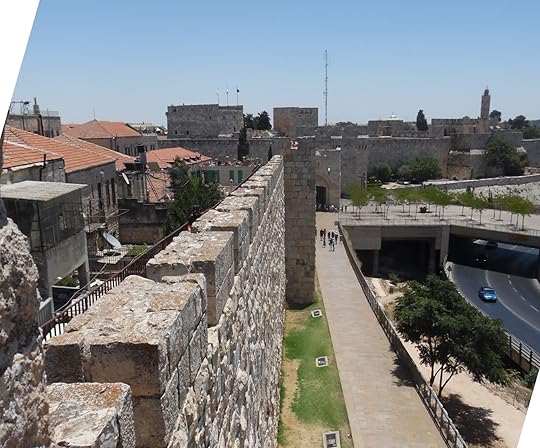 The outside of Jaffa Gate from the top of the wallsMost people pass in and out of the wide Jaffa Gate with no notice of these two graves, for this international gate is the portal into Jerusalem’s oldest and one of it’s newest marketplaces. The walls of Jerusalem contain a vast marketplace spreading out from David Street which leads toward Temple Mount. An entrance to the Mamilla Mall can be found when exiting the old city through the Jaffa Gate. Below the mall visitors will enjoy the fountains, shops and sights of Teddy Park.
The outside of Jaffa Gate from the top of the wallsMost people pass in and out of the wide Jaffa Gate with no notice of these two graves, for this international gate is the portal into Jerusalem’s oldest and one of it’s newest marketplaces. The walls of Jerusalem contain a vast marketplace spreading out from David Street which leads toward Temple Mount. An entrance to the Mamilla Mall can be found when exiting the old city through the Jaffa Gate. Below the mall visitors will enjoy the fountains, shops and sights of Teddy Park. Join me for a great tour of Israel
Join me for a great tour of Israel
Jerusalem with its gates and holy sites is worth a visit. Please join me on my next trip May 5-18, 2018 (click this link for more details). If you can not go, please order my $2 book, Israel: Stories for Your Journey.
 Jaffa Gate from inside the walls of JerusalemThe Jaffa Gate is, in a way, the international gate of Jerusalem. The name shared most often today motions away from the city to the port city of Jaffa (and beyond that to Caesarea), from which travelers arrive into Eretz Yisrael from all over the world. From the days of King David, when King Hiram of Phoenicia passed by this gate, even until today travelers and others have written about the beautiful Jaffa Gate.
Jaffa Gate from inside the walls of JerusalemThe Jaffa Gate is, in a way, the international gate of Jerusalem. The name shared most often today motions away from the city to the port city of Jaffa (and beyond that to Caesarea), from which travelers arrive into Eretz Yisrael from all over the world. From the days of King David, when King Hiram of Phoenicia passed by this gate, even until today travelers and others have written about the beautiful Jaffa Gate. Looking down from the top of the Rampart WallsAt one time the gate was heavily guarded, with a double entry and heavy wooden doors which sat upon bronze hinges. Towers guarded this entrance, portions of which still stand today. King Herod named these towers Phasael (145’ high), Hippicus (132’) and Mariamne (74’) after his brother, a friend, and his favorite wife. Of these, only a portion of the Phasael tower stands today, and the gates were removed to allow Kaiser Wilhelm II easier access to the city in 1898. (More in my book, Israel: Stories for Your Journey)
Looking down from the top of the Rampart WallsAt one time the gate was heavily guarded, with a double entry and heavy wooden doors which sat upon bronze hinges. Towers guarded this entrance, portions of which still stand today. King Herod named these towers Phasael (145’ high), Hippicus (132’) and Mariamne (74’) after his brother, a friend, and his favorite wife. Of these, only a portion of the Phasael tower stands today, and the gates were removed to allow Kaiser Wilhelm II easier access to the city in 1898. (More in my book, Israel: Stories for Your Journey) A must for tourists to IsraelMost of the walls and gates of Jerusalem, which we see today, were ordered to be constructed by Sultan Suleiman the Magnificent who ruled the Ottoman Empire in the sixteenth century. A story is told of how he found the walls of Jerusalem in ruins after being visited by four lions in a dream. He sent two architects to build a wall following the original course of the city’s protective enclosure. When completed the Sultan visited the city, and when inspecting the work found it satisfactory with one exception. The Tomb of King David was left outside the walls. The two architects were hanged and put to rest in graves outside the Jaffa Gate.
A must for tourists to IsraelMost of the walls and gates of Jerusalem, which we see today, were ordered to be constructed by Sultan Suleiman the Magnificent who ruled the Ottoman Empire in the sixteenth century. A story is told of how he found the walls of Jerusalem in ruins after being visited by four lions in a dream. He sent two architects to build a wall following the original course of the city’s protective enclosure. When completed the Sultan visited the city, and when inspecting the work found it satisfactory with one exception. The Tomb of King David was left outside the walls. The two architects were hanged and put to rest in graves outside the Jaffa Gate. The outside of Jaffa Gate from the top of the wallsMost people pass in and out of the wide Jaffa Gate with no notice of these two graves, for this international gate is the portal into Jerusalem’s oldest and one of it’s newest marketplaces. The walls of Jerusalem contain a vast marketplace spreading out from David Street which leads toward Temple Mount. An entrance to the Mamilla Mall can be found when exiting the old city through the Jaffa Gate. Below the mall visitors will enjoy the fountains, shops and sights of Teddy Park.
The outside of Jaffa Gate from the top of the wallsMost people pass in and out of the wide Jaffa Gate with no notice of these two graves, for this international gate is the portal into Jerusalem’s oldest and one of it’s newest marketplaces. The walls of Jerusalem contain a vast marketplace spreading out from David Street which leads toward Temple Mount. An entrance to the Mamilla Mall can be found when exiting the old city through the Jaffa Gate. Below the mall visitors will enjoy the fountains, shops and sights of Teddy Park. Join me for a great tour of Israel
Join me for a great tour of IsraelJerusalem with its gates and holy sites is worth a visit. Please join me on my next trip May 5-18, 2018 (click this link for more details). If you can not go, please order my $2 book, Israel: Stories for Your Journey.
Published on February 07, 2018 02:30
February 2, 2018
A Jewish Dinner … in Church?
The title of this blog leads us to a dilemma with a long history. The Bible records that the church was started by a Jewish teacher named Jesus, who came from heaven to provide salvation for all who believe. This Rabbi taught the world about God through the context of his Jewish faith. He used the Jewish Bible, observed Jewish customs and participated in the Jewish festivals. His final meal before he died was a Passover Seder. (Mt 26:17-19; Mk 14:12-16; Lk 22:7-16; Jn 13:1)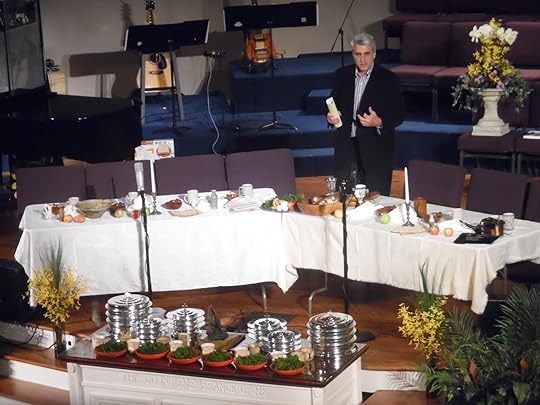 The Last Supper of Jesus was a sit down eventFollowing the death, burial and resurrection of Jesus, the early disciples, who were all Jewish, began to teach the message of their Lord to the Jew first and also to the Greeks. A large number of gentiles came to believe the message of Jesus, and in time, these people called their faith in Jesus, Christianity. The early church ate a dinner similar to the Passover called the Agape Feast. (Ro 14:13-21; 1 Cor 10-11; Col 2:16; Jude 1:12)
The Last Supper of Jesus was a sit down eventFollowing the death, burial and resurrection of Jesus, the early disciples, who were all Jewish, began to teach the message of their Lord to the Jew first and also to the Greeks. A large number of gentiles came to believe the message of Jesus, and in time, these people called their faith in Jesus, Christianity. The early church ate a dinner similar to the Passover called the Agape Feast. (Ro 14:13-21; 1 Cor 10-11; Col 2:16; Jude 1:12)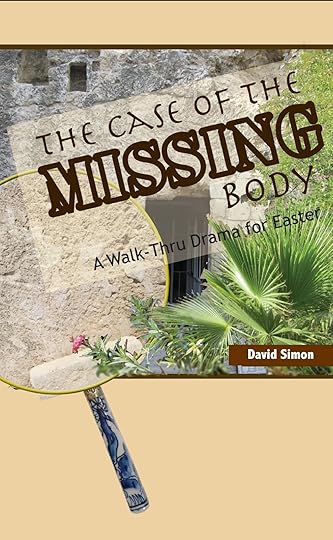 A drama about the ResurrectionIn the beginning, many Jewish traditions were followed among believers in Jesus. But as the church grew and spread to the ends of the world, things changed. A largely gentile world developed new traditions and the Jewish ways were no longer followed. By the end of the first century, Ignatius, the bishop of Antioch wrote letters to churches across Asia Minor and told them, “If any one celebrates the passover along with the Jews, or receives the emblems of their feast, he is a partaker with those that killed the Lord and His apostles.” (Letter to the Philippians 14)
A drama about the ResurrectionIn the beginning, many Jewish traditions were followed among believers in Jesus. But as the church grew and spread to the ends of the world, things changed. A largely gentile world developed new traditions and the Jewish ways were no longer followed. By the end of the first century, Ignatius, the bishop of Antioch wrote letters to churches across Asia Minor and told them, “If any one celebrates the passover along with the Jews, or receives the emblems of their feast, he is a partaker with those that killed the Lord and His apostles.” (Letter to the Philippians 14) Passover builds relationship with GodThe celebration of the Passover as a common meal was the practice of Jesus and of the early church. Sharing this festival as a teaching in the home and as a celebration of the church fell out of practice in the second century, and as it did weakened the congregants of the church. The format of the dinner “feels strange” among people used to attending a service rather than participating in a teaching event.
Passover builds relationship with GodThe celebration of the Passover as a common meal was the practice of Jesus and of the early church. Sharing this festival as a teaching in the home and as a celebration of the church fell out of practice in the second century, and as it did weakened the congregants of the church. The format of the dinner “feels strange” among people used to attending a service rather than participating in a teaching event.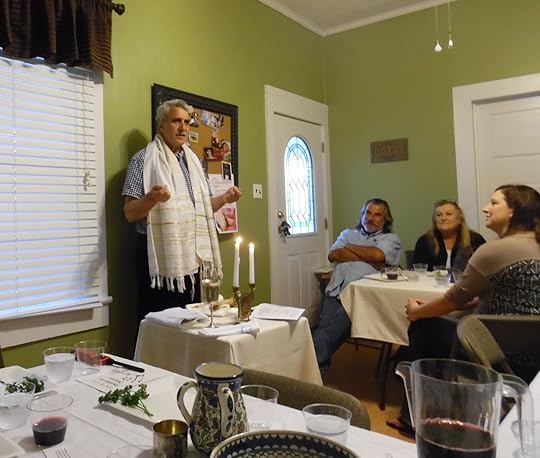 Passover in the homeThe church replaced Jewish traditions which sought to teach faith in the home with ceremonies developed in order to empower the bishop. People began to place their loyalties in the priest rather than God. The historic ways which were practiced by Jesus and his family in their home and community were discarded to fuel an organized religion.
Passover in the homeThe church replaced Jewish traditions which sought to teach faith in the home with ceremonies developed in order to empower the bishop. People began to place their loyalties in the priest rather than God. The historic ways which were practiced by Jesus and his family in their home and community were discarded to fuel an organized religion. Passover shared with a large groupA Passover dinner led in the traditional format (not from the pulpit), can teach a number of things to a church congregation. The dinner teaches the age old story of how God freed His people from Egyptian slavery. It displays the background in which Jesus shared His message of redemption on the very night He was betrayed. If presented correctly the Passover Seder will teach parents how to instruct their children in the faith at home, which will result in stronger and more self sustaining churches.
Passover shared with a large groupA Passover dinner led in the traditional format (not from the pulpit), can teach a number of things to a church congregation. The dinner teaches the age old story of how God freed His people from Egyptian slavery. It displays the background in which Jesus shared His message of redemption on the very night He was betrayed. If presented correctly the Passover Seder will teach parents how to instruct their children in the faith at home, which will result in stronger and more self sustaining churches.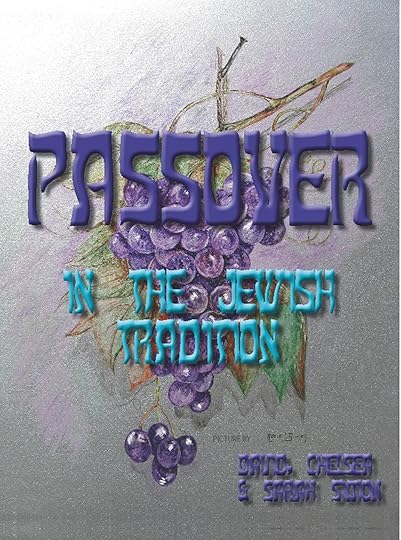 A Passover resource that explains everything
A Passover resource that explains everything
I have written a book to help pastors, churches and families to present a Passover Seder in its original context. I sought to re-created the meal enjoyed every year by my extended family so it could become a looked-forward-to tradition in Christian homes and churches. A Christian Passover in the Jewish Tradition will equip parents to lead the dinner at home (as it was in the time of Jesus) and pastors to model the dinner for their congregations. I have produced a $1 Kindle book so families and congregations can read along and join in the Passover celebration. My book Spring: Connecting with God shows how celebrating the Passover as families gave strength to the people of Israel. And this tradition can bring strength to churches today.
 The Last Supper of Jesus was a sit down eventFollowing the death, burial and resurrection of Jesus, the early disciples, who were all Jewish, began to teach the message of their Lord to the Jew first and also to the Greeks. A large number of gentiles came to believe the message of Jesus, and in time, these people called their faith in Jesus, Christianity. The early church ate a dinner similar to the Passover called the Agape Feast. (Ro 14:13-21; 1 Cor 10-11; Col 2:16; Jude 1:12)
The Last Supper of Jesus was a sit down eventFollowing the death, burial and resurrection of Jesus, the early disciples, who were all Jewish, began to teach the message of their Lord to the Jew first and also to the Greeks. A large number of gentiles came to believe the message of Jesus, and in time, these people called their faith in Jesus, Christianity. The early church ate a dinner similar to the Passover called the Agape Feast. (Ro 14:13-21; 1 Cor 10-11; Col 2:16; Jude 1:12) A drama about the ResurrectionIn the beginning, many Jewish traditions were followed among believers in Jesus. But as the church grew and spread to the ends of the world, things changed. A largely gentile world developed new traditions and the Jewish ways were no longer followed. By the end of the first century, Ignatius, the bishop of Antioch wrote letters to churches across Asia Minor and told them, “If any one celebrates the passover along with the Jews, or receives the emblems of their feast, he is a partaker with those that killed the Lord and His apostles.” (Letter to the Philippians 14)
A drama about the ResurrectionIn the beginning, many Jewish traditions were followed among believers in Jesus. But as the church grew and spread to the ends of the world, things changed. A largely gentile world developed new traditions and the Jewish ways were no longer followed. By the end of the first century, Ignatius, the bishop of Antioch wrote letters to churches across Asia Minor and told them, “If any one celebrates the passover along with the Jews, or receives the emblems of their feast, he is a partaker with those that killed the Lord and His apostles.” (Letter to the Philippians 14) Passover builds relationship with GodThe celebration of the Passover as a common meal was the practice of Jesus and of the early church. Sharing this festival as a teaching in the home and as a celebration of the church fell out of practice in the second century, and as it did weakened the congregants of the church. The format of the dinner “feels strange” among people used to attending a service rather than participating in a teaching event.
Passover builds relationship with GodThe celebration of the Passover as a common meal was the practice of Jesus and of the early church. Sharing this festival as a teaching in the home and as a celebration of the church fell out of practice in the second century, and as it did weakened the congregants of the church. The format of the dinner “feels strange” among people used to attending a service rather than participating in a teaching event. Passover in the homeThe church replaced Jewish traditions which sought to teach faith in the home with ceremonies developed in order to empower the bishop. People began to place their loyalties in the priest rather than God. The historic ways which were practiced by Jesus and his family in their home and community were discarded to fuel an organized religion.
Passover in the homeThe church replaced Jewish traditions which sought to teach faith in the home with ceremonies developed in order to empower the bishop. People began to place their loyalties in the priest rather than God. The historic ways which were practiced by Jesus and his family in their home and community were discarded to fuel an organized religion. Passover shared with a large groupA Passover dinner led in the traditional format (not from the pulpit), can teach a number of things to a church congregation. The dinner teaches the age old story of how God freed His people from Egyptian slavery. It displays the background in which Jesus shared His message of redemption on the very night He was betrayed. If presented correctly the Passover Seder will teach parents how to instruct their children in the faith at home, which will result in stronger and more self sustaining churches.
Passover shared with a large groupA Passover dinner led in the traditional format (not from the pulpit), can teach a number of things to a church congregation. The dinner teaches the age old story of how God freed His people from Egyptian slavery. It displays the background in which Jesus shared His message of redemption on the very night He was betrayed. If presented correctly the Passover Seder will teach parents how to instruct their children in the faith at home, which will result in stronger and more self sustaining churches. A Passover resource that explains everything
A Passover resource that explains everythingI have written a book to help pastors, churches and families to present a Passover Seder in its original context. I sought to re-created the meal enjoyed every year by my extended family so it could become a looked-forward-to tradition in Christian homes and churches. A Christian Passover in the Jewish Tradition will equip parents to lead the dinner at home (as it was in the time of Jesus) and pastors to model the dinner for their congregations. I have produced a $1 Kindle book so families and congregations can read along and join in the Passover celebration. My book Spring: Connecting with God shows how celebrating the Passover as families gave strength to the people of Israel. And this tradition can bring strength to churches today.
Published on February 02, 2018 03:30
January 29, 2018
When King Herod was Little
While Beit Guvrin and Maresha, towns not familiar to most people who study the Bible, knowing what happened in these towns will give clues to the formation of King Herod’s personality. In all probability King Herod the great was born and grew up in the region of these cities. Josephus contains a reference to this fact in the Antiquities of the Jews 14.13.9. The town of Maresha is very ancient, Joshua makes a note that this village was part of the inheritance of the tribe of Judah. (15:20, 44). Rehoboam fortified the city (2 Chronicles 11: 5-8) and later Nebuchadnezzar depopulated the region.
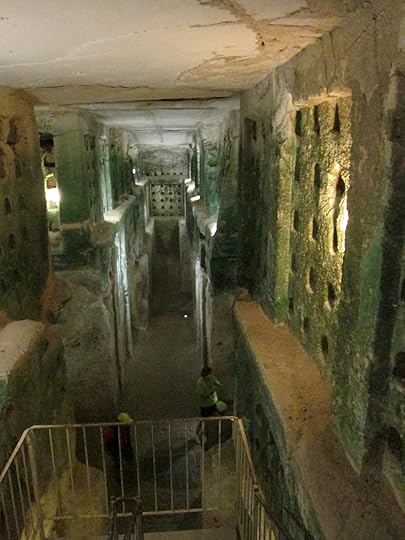 The Dove Farm at Beit GuvrinWhen the people of Judah were away in captivity to Babylon, Nabateans, then Edomites (Idumeans), and finally Greeks entered the land in the Guvrin valley. These new people adopted the vacated olive groves (which originally drew them to the land), and brought with them textile and dove breeding industries which prospered in the valley.
The Dove Farm at Beit GuvrinWhen the people of Judah were away in captivity to Babylon, Nabateans, then Edomites (Idumeans), and finally Greeks entered the land in the Guvrin valley. These new people adopted the vacated olive groves (which originally drew them to the land), and brought with them textile and dove breeding industries which prospered in the valley.
After the Maccabees came to power, Beit Guvrin and Maresha became a target for their new Hebrew state, because it was in the former territory of Judah. In battle they defeated the people who lived in the valley and once captured, Maresha became a regional capital for the Jews, who forcibly converted its inhabitants to Judaism. One of the Idumean inhabitants, Antipater, posed a challenge to the new Jewish rulers.
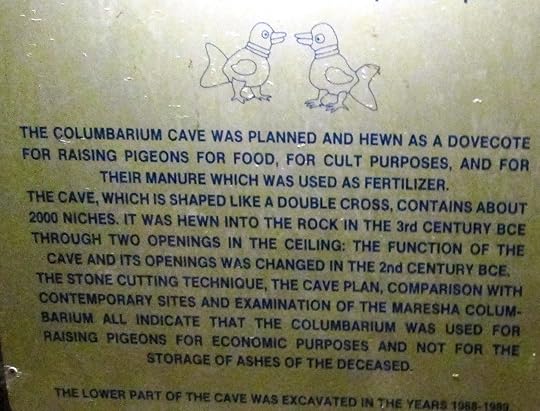 The Dove industry was large when Herod was a boyAntipater was Herod’s father. History records he was a very rich, politically active, and seditious man who owned a great amount of property in Maresha (which is what the village was called at that time). He inherited these from his father, who carried the same name. Josephus wrote; ‘’Tis true, that Nicolaus of Damascus says, that Antipater was of the stock of the principal Jews who came out of Babylon into Judea. But that assertion of his was to gratify Herod, who was his son; and who, by certain revolutions of fortune, came afterward to be King of the Jews.” (Ant. 14.1.3)
The Dove industry was large when Herod was a boyAntipater was Herod’s father. History records he was a very rich, politically active, and seditious man who owned a great amount of property in Maresha (which is what the village was called at that time). He inherited these from his father, who carried the same name. Josephus wrote; ‘’Tis true, that Nicolaus of Damascus says, that Antipater was of the stock of the principal Jews who came out of Babylon into Judea. But that assertion of his was to gratify Herod, who was his son; and who, by certain revolutions of fortune, came afterward to be King of the Jews.” (Ant. 14.1.3)
 The short stories in this book illustrate Herod's childhood
The short stories in this book illustrate Herod's childhood
In my new book I develop a story about how the young boy Herod grew up in Maresha and received early training from his father in the textile and then the dove industry. He learned valuable lessons in leadership when his father placed in in management. The future king learned his cruelty by observing personality types while tending the doves his father owned. I share stories about how Herod’s childhood in Beit Guvrin and Maresha shaped events of the New Testament in my book, Israel: Stories for Your Journey, available on Amazon.com.
 The Dove Farm at Beit GuvrinWhen the people of Judah were away in captivity to Babylon, Nabateans, then Edomites (Idumeans), and finally Greeks entered the land in the Guvrin valley. These new people adopted the vacated olive groves (which originally drew them to the land), and brought with them textile and dove breeding industries which prospered in the valley.
The Dove Farm at Beit GuvrinWhen the people of Judah were away in captivity to Babylon, Nabateans, then Edomites (Idumeans), and finally Greeks entered the land in the Guvrin valley. These new people adopted the vacated olive groves (which originally drew them to the land), and brought with them textile and dove breeding industries which prospered in the valley.After the Maccabees came to power, Beit Guvrin and Maresha became a target for their new Hebrew state, because it was in the former territory of Judah. In battle they defeated the people who lived in the valley and once captured, Maresha became a regional capital for the Jews, who forcibly converted its inhabitants to Judaism. One of the Idumean inhabitants, Antipater, posed a challenge to the new Jewish rulers.
 The Dove industry was large when Herod was a boyAntipater was Herod’s father. History records he was a very rich, politically active, and seditious man who owned a great amount of property in Maresha (which is what the village was called at that time). He inherited these from his father, who carried the same name. Josephus wrote; ‘’Tis true, that Nicolaus of Damascus says, that Antipater was of the stock of the principal Jews who came out of Babylon into Judea. But that assertion of his was to gratify Herod, who was his son; and who, by certain revolutions of fortune, came afterward to be King of the Jews.” (Ant. 14.1.3)
The Dove industry was large when Herod was a boyAntipater was Herod’s father. History records he was a very rich, politically active, and seditious man who owned a great amount of property in Maresha (which is what the village was called at that time). He inherited these from his father, who carried the same name. Josephus wrote; ‘’Tis true, that Nicolaus of Damascus says, that Antipater was of the stock of the principal Jews who came out of Babylon into Judea. But that assertion of his was to gratify Herod, who was his son; and who, by certain revolutions of fortune, came afterward to be King of the Jews.” (Ant. 14.1.3) The short stories in this book illustrate Herod's childhood
The short stories in this book illustrate Herod's childhoodIn my new book I develop a story about how the young boy Herod grew up in Maresha and received early training from his father in the textile and then the dove industry. He learned valuable lessons in leadership when his father placed in in management. The future king learned his cruelty by observing personality types while tending the doves his father owned. I share stories about how Herod’s childhood in Beit Guvrin and Maresha shaped events of the New Testament in my book, Israel: Stories for Your Journey, available on Amazon.com.
Published on January 29, 2018 05:47
January 26, 2018
Jaffa and History
Joppa, Jaffa, Yafo, Yaffe, however you spell the name, is a city with a history. Last week in my class we looked at the events which occurred in or around this city, which was built on a hill overlooking the Mediterranean Sea.
 The view from Joppa
The view from JoppaSome of the most popular stories claim that Jaffa was founded by Japheth, the son of Noah. Although there is no proof of this matter, we do know that people (probably Canaanites) lived upon the hill of Jaffe by 2018 BC (not AD!) these people sought the hillside location for safety, and eventually built a wall around their community in order to defend themselves from attacks. By day they would grow crops, hunt, or go out fishing, and by night they would sleep safely inside the closed city gates.
 A historic picture of Joppa
A historic picture of JoppaBut history was not kind to Jaffa, because neither their hill nor their walls were high enough to keep intruders away. Pharaoh Thutmose III captured the city in about 1600 BC. It is said that he orchestrated an “inside attack” by offering the citizens 100 baskets of Egyptian “treasure,” carried in by 200 Egyptian “porters.” Both the “treasure” and the porters” were really Egyptian soldiers, and once inside the city gates, the city was an easy capture. Ramesses II was there in 1258 BC, as evidenced by a lion scarab and other archaeological finds. Both before, after and in between these two Pharaohs, other Egyptian rulers also called this city a possession and collected tribute from the people in Joppa.
 Pharaohs visited JoppaAlong history’s path, the Bible tells of others who visited Joppa over the course of the centuries. It is recorded that Joshua and the army of Israel marched toward the sea along the Aylon River in Israel. This river used to empty into the Mediterranean near Joppa (it has been rerouted). From this march, Joshua turned south and captured other Canaanite villages, including Gezer and Lachish. King Solomon, likewise visited Jaffa in order to retrieve Cedar for the Temple which entered Israel at the port of Joppa.
Pharaohs visited JoppaAlong history’s path, the Bible tells of others who visited Joppa over the course of the centuries. It is recorded that Joshua and the army of Israel marched toward the sea along the Aylon River in Israel. This river used to empty into the Mediterranean near Joppa (it has been rerouted). From this march, Joshua turned south and captured other Canaanite villages, including Gezer and Lachish. King Solomon, likewise visited Jaffa in order to retrieve Cedar for the Temple which entered Israel at the port of Joppa. The Harbor at Joppa
The Harbor at JoppaJoppa saw action as Assyrian kings Shalmaneser III, Tiglath Pileser III, Shalmaneser V, and Sargon II conquered Israel and fought against Egypt along the coastal highway. The prophet Jonah sought to escape a preaching assignment to Assyria during this period by taking the first ship out of Joppa to Tarshish. The prophet’s escape did not last long, because God brought up a storm which forced Jonah to be thrown from the boat, where he was saved by a fish who safely returned him to the beach near Yafo.
 The story of AndromedaIn 412 BC, another story is told of a young woman who was saved from the sea. As the story goes, King Cepheus and his wife Cassiopeia, who ruled the city of Joppa, used to brag to everyone about the beauty of their daughter, Andromeda. They once said she was even more beautiful than the daughters of Poseidon. This angered the sea king, who demanded that Andromeda be chained to a rock in the harbor in order to save King Cepheus’s city from destruction. Andromeda would have been eaten alive by a giant sea creature, had not Greek god Perseus saved her.
The story of AndromedaIn 412 BC, another story is told of a young woman who was saved from the sea. As the story goes, King Cepheus and his wife Cassiopeia, who ruled the city of Joppa, used to brag to everyone about the beauty of their daughter, Andromeda. They once said she was even more beautiful than the daughters of Poseidon. This angered the sea king, who demanded that Andromeda be chained to a rock in the harbor in order to save King Cepheus’s city from destruction. Andromeda would have been eaten alive by a giant sea creature, had not Greek god Perseus saved her. A New Book on Israel
A New Book on IsraelOver the years, Joppa has never been out of the limelight, and many other stories could be told. I have written a few more in my book, Israel: Stories for Your Journey. I will tell and learn others on a future trip to Israel. For more information, check out my webpage at www.KosherCopy.com.
Published on January 26, 2018 01:30
January 22, 2018
Israel's Long History
One of the amazing things about the Holy Land is their long history. In the United States, most historic sites tell stories from only a hundred or two hundred years ago, and the most ancient sites only go back five hundred years. It is therefore amazing when I go to Israel where “new” can be five hundred years old and it is common to stand at the location of events which go back 3,000 years or more.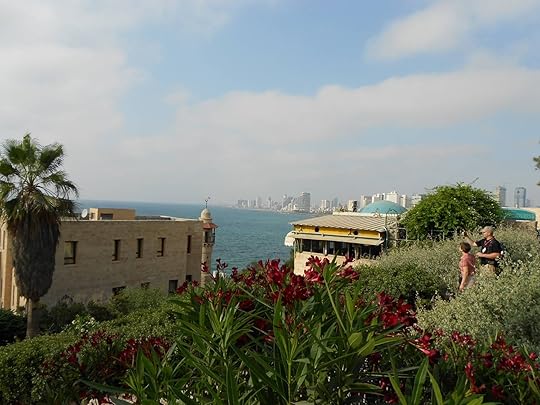 The view from Old Joppa to New Tel AvivIn my class about Israel this week I introduced people to the city of Joppa, which was an ancient port of arrival into the Holy Land. At least one history records that Joppa was founded and took its name from Japeth, the son of Noah. Japheth left home after the flood and founded this seaside community because of its beauty (Joppa means beautiful).
The view from Old Joppa to New Tel AvivIn my class about Israel this week I introduced people to the city of Joppa, which was an ancient port of arrival into the Holy Land. At least one history records that Joppa was founded and took its name from Japeth, the son of Noah. Japheth left home after the flood and founded this seaside community because of its beauty (Joppa means beautiful).
 A New book on IsraelUpon thinking about Japheth’s founding of Joppa, I began to think of other stories I read about Israel for one of my latest books, Israel: Stories for Your Journey. The residents of Gezer, located only twenty miles from Joppa, claim that Noah lived on the hilltop of their city. It is claimed that Noah’s wife, his daughter, and also Adam’s wife Eve baked bread in an oven near the city.
A New book on IsraelUpon thinking about Japheth’s founding of Joppa, I began to think of other stories I read about Israel for one of my latest books, Israel: Stories for Your Journey. The residents of Gezer, located only twenty miles from Joppa, claim that Noah lived on the hilltop of their city. It is claimed that Noah’s wife, his daughter, and also Adam’s wife Eve baked bread in an oven near the city.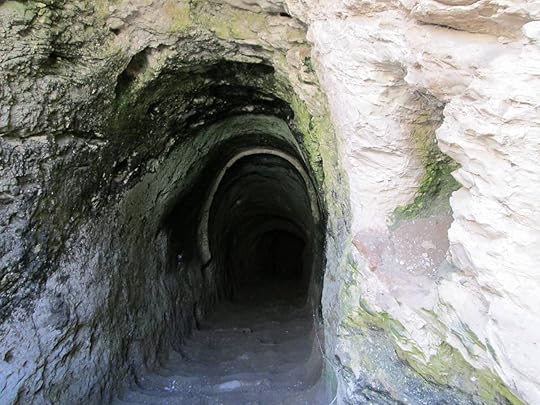 The Cavernous water source at GezerWalks in Israel can be walks through history, if you listen to the stories. Everyone wants a piece of the action and to tell a familiar tale about the past. Did Japheth really found Joppa? Did Noah live in Gezer? Did Eve bake bread in the cavernous hole near Gezer’s city gate? Probably not, but the stories are fun, and the reality of the matter is that people have lived in Joppa and atop the hill at Gezer for a very long time.
The Cavernous water source at GezerWalks in Israel can be walks through history, if you listen to the stories. Everyone wants a piece of the action and to tell a familiar tale about the past. Did Japheth really found Joppa? Did Noah live in Gezer? Did Eve bake bread in the cavernous hole near Gezer’s city gate? Probably not, but the stories are fun, and the reality of the matter is that people have lived in Joppa and atop the hill at Gezer for a very long time.
 The view from Old Joppa to New Tel AvivIn my class about Israel this week I introduced people to the city of Joppa, which was an ancient port of arrival into the Holy Land. At least one history records that Joppa was founded and took its name from Japeth, the son of Noah. Japheth left home after the flood and founded this seaside community because of its beauty (Joppa means beautiful).
The view from Old Joppa to New Tel AvivIn my class about Israel this week I introduced people to the city of Joppa, which was an ancient port of arrival into the Holy Land. At least one history records that Joppa was founded and took its name from Japeth, the son of Noah. Japheth left home after the flood and founded this seaside community because of its beauty (Joppa means beautiful).
 A New book on IsraelUpon thinking about Japheth’s founding of Joppa, I began to think of other stories I read about Israel for one of my latest books, Israel: Stories for Your Journey. The residents of Gezer, located only twenty miles from Joppa, claim that Noah lived on the hilltop of their city. It is claimed that Noah’s wife, his daughter, and also Adam’s wife Eve baked bread in an oven near the city.
A New book on IsraelUpon thinking about Japheth’s founding of Joppa, I began to think of other stories I read about Israel for one of my latest books, Israel: Stories for Your Journey. The residents of Gezer, located only twenty miles from Joppa, claim that Noah lived on the hilltop of their city. It is claimed that Noah’s wife, his daughter, and also Adam’s wife Eve baked bread in an oven near the city. The Cavernous water source at GezerWalks in Israel can be walks through history, if you listen to the stories. Everyone wants a piece of the action and to tell a familiar tale about the past. Did Japheth really found Joppa? Did Noah live in Gezer? Did Eve bake bread in the cavernous hole near Gezer’s city gate? Probably not, but the stories are fun, and the reality of the matter is that people have lived in Joppa and atop the hill at Gezer for a very long time.
The Cavernous water source at GezerWalks in Israel can be walks through history, if you listen to the stories. Everyone wants a piece of the action and to tell a familiar tale about the past. Did Japheth really found Joppa? Did Noah live in Gezer? Did Eve bake bread in the cavernous hole near Gezer’s city gate? Probably not, but the stories are fun, and the reality of the matter is that people have lived in Joppa and atop the hill at Gezer for a very long time.
Published on January 22, 2018 10:42



